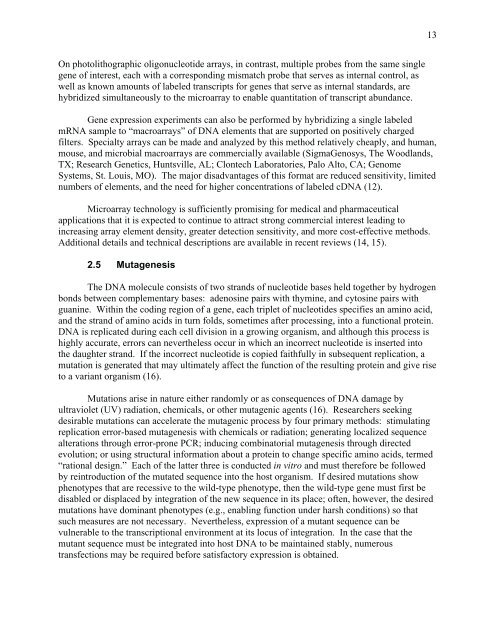Bioengineering for Pollution Prevention (PDF) - US Environmental ...
Bioengineering for Pollution Prevention (PDF) - US Environmental ...
Bioengineering for Pollution Prevention (PDF) - US Environmental ...
You also want an ePaper? Increase the reach of your titles
YUMPU automatically turns print PDFs into web optimized ePapers that Google loves.
On photolithographic oligonucleotide arrays, in contrast, multiple probes from the same single<br />
gene of interest, each with a corresponding mismatch probe that serves as internal control, as<br />
well as known amounts of labeled transcripts <strong>for</strong> genes that serve as internal standards, are<br />
hybridized simultaneously to the microarray to enable quantitation of transcript abundance.<br />
Gene expression experiments can also be per<strong>for</strong>med by hybridizing a single labeled<br />
mRNA sample to “macroarrays” of DNA elements that are supported on positively charged<br />
filters. Specialty arrays can be made and analyzed by this method relatively cheaply, and human,<br />
mouse, and microbial macroarrays are commercially available (SigmaGenosys, The Woodlands,<br />
TX; Research Genetics, Huntsville, AL; Clontech Laboratories, Palo Alto, CA; Genome<br />
Systems, St. Louis, MO). The major disadvantages of this <strong>for</strong>mat are reduced sensitivity, limited<br />
numbers of elements, and the need <strong>for</strong> higher concentrations of labeled cDNA (12).<br />
Microarray technology is sufficiently promising <strong>for</strong> medical and pharmaceutical<br />
applications that it is expected to continue to attract strong commercial interest leading to<br />
increasing array element density, greater detection sensitivity, and more cost-effective methods.<br />
Additional details and technical descriptions are available in recent reviews (14, 15).<br />
2.5 Mutagenesis<br />
The DNA molecule consists of two strands of nucleotide bases held together by hydrogen<br />
bonds between complementary bases: adenosine pairs with thymine, and cytosine pairs with<br />
guanine. Within the coding region of a gene, each triplet of nucleotides specifies an amino acid,<br />
and the strand of amino acids in turn folds, sometimes after processing, into a functional protein.<br />
DNA is replicated during each cell division in a growing organism, and although this process is<br />
highly accurate, errors can nevertheless occur in which an incorrect nucleotide is inserted into<br />
the daughter strand. If the incorrect nucleotide is copied faithfully in subsequent replication, a<br />
mutation is generated that may ultimately affect the function of the resulting protein and give rise<br />
to a variant organism (16).<br />
Mutations arise in nature either randomly or as consequences of DNA damage by<br />
ultraviolet (UV) radiation, chemicals, or other mutagenic agents (16). Researchers seeking<br />
desirable mutations can accelerate the mutagenic process by four primary methods: stimulating<br />
replication error-based mutagenesis with chemicals or radiation; generating localized sequence<br />
alterations through error-prone PCR; inducing combinatorial mutagenesis through directed<br />
evolution; or using structural in<strong>for</strong>mation about a protein to change specific amino acids, termed<br />
“rational design.” Each of the latter three is conducted in vitro and must there<strong>for</strong>e be followed<br />
by reintroduction of the mutated sequence into the host organism. If desired mutations show<br />
phenotypes that are recessive to the wild-type phenotype, then the wild-type gene must first be<br />
disabled or displaced by integration of the new sequence in its place; often, however, the desired<br />
mutations have dominant phenotypes (e.g., enabling function under harsh conditions) so that<br />
such measures are not necessary. Nevertheless, expression of a mutant sequence can be<br />
vulnerable to the transcriptional environment at its locus of integration. In the case that the<br />
mutant sequence must be integrated into host DNA to be maintained stably, numerous<br />
transfections may be required be<strong>for</strong>e satisfactory expression is obtained.<br />
13

















